Selling furniture online can be incredibly lucrative. But in today’s digital age, simply having a website isn’t enough. You need a furniture store website that’s not just visually appealing but also user-friendly, optimized for search engines, and designed to convert visitors into paying customers. This guide will walk you through the essential steps to create a furniture store website that stands out from the competition.
Quick Summary:
- Define your brand, niche, and target audience first.
- Choose a strong e-commerce platform for your store.
- Design a visually appealing, fast, and SEO-friendly website.
- Offer clear payments, shipping, and excellent customer service.
Table of Contents
- 1. Defining Your Brand and Target Audience
- 1.1 Identifying Your Furniture Niche
- 1.2 Understanding Your Target Audience
- 1.3 Crafting Your Brand Identity
- 2. Choosing the Right E-commerce Platform
- 2.1 Popular E-commerce Platforms for Furniture Stores
- 2.2 Key Features to Consider
- 2.3 Scalability and Future Growth
- 3. Designing Your Furniture Store Website
- 3.1 Choosing a Theme or Template
- 3.2 Structuring Your Website Navigation
- 3.3 High-Quality Product Photography
- 3.4 Incorporating 3D Models and Augmented Reality (AR)
- 3.5 Website Speed and Performance
- 4. Optimizing Your Website for Search Engines (SEO)
- 4.1 Keyword Research
- 4.2 On-Page Optimization
- 4.3 Off-Page Optimization
- 4.4 Mobile Optimization
- 4.5 Local SEO
- 5. Setting Up Payment and Shipping Options
- 5.1 Payment Gateway Integration
- 5.2 Shipping Options and Rates
- 5.3 Order Fulfillment
- 6. Marketing and Promotion
- 6.1 Email Marketing
- 6.2 Social Media Marketing
- 6.3 Paid Advertising
- 6.4 Content Marketing
- 6.5 Influencer Marketing
- 7. Customer Service and Support
- 7.1 Live Chat
- 7.2 Email Support
- 7.3 Phone Support
- 7.4 Returns and Exchanges
- 7.5 Customer Reviews
- 8. Website Maintenance and Updates
- 8.1 Security Updates
- 8.2 Content Updates
- 8.3 Performance Monitoring
- 9. Qrolic Technologies: Your Partner in Building a Successful Furniture Store Website
- 9.1 Services Offered
- 9.2 Benefits of Choosing Qrolic Technologies
- 10. Measuring Your Success
1. Defining Your Brand and Target Audience

Before diving into the technical aspects, understanding your brand and target audience is crucial. This understanding will inform every decision, from your website’s design to your marketing strategy.
1.1 Identifying Your Furniture Niche
What type of furniture do you specialize in? Are you focused on:
- Modern Furniture: Sleek lines, minimalist design, and contemporary materials.
- Rustic Furniture: Natural wood, distressed finishes, and a focus on craftsmanship.
- Mid-Century Modern Furniture: Iconic designs from the 1950s and 1960s.
- Luxury Furniture: High-end materials, exquisite craftsmanship, and exclusive designs.
- Outdoor Furniture: Durable materials, weather-resistant designs, and comfortable seating.
- Office Furniture: Ergonomic designs, practical functionality, and professional aesthetics.
- Eco-Friendly Furniture: Sustainable materials, ethical manufacturing practices, and environmentally conscious designs.
- Custom Furniture: Made-to-order pieces tailored to individual client specifications.
Why it matters: Defining your niche helps you target your marketing efforts and attract customers specifically interested in your offerings. It also allows you to curate your product selection and messaging for a specific audience.
1.2 Understanding Your Target Audience
Who are you trying to reach? Consider factors like:
- Demographics: Age, gender, location, income, education, and occupation.
- Psychographics: Lifestyle, values, interests, and attitudes.
- Buying Behavior: How often do they purchase furniture? What motivates their buying decisions? What are their pain points when shopping for furniture?
Example: If you specialize in modern furniture, your target audience might be young professionals and design enthusiasts living in urban areas who appreciate minimalist aesthetics and are willing to invest in quality pieces.
1.3 Crafting Your Brand Identity
Your brand identity is how you present yourself to the world. It includes:
- Brand Name: Memorable, relevant, and easy to pronounce.
- Logo: Visually appealing and representative of your brand’s personality.
- Color Palette: Consistent across your website and marketing materials. Evoke certain emotions (e.g., blue for trust, green for nature).
- Typography: Readable and consistent with your brand’s style.
- Brand Voice: The tone and style of your communication (e.g., friendly, professional, sophisticated).
Why it matters: A strong brand identity helps you differentiate yourself from competitors and build brand recognition.
2. Choosing the Right E-commerce Platform
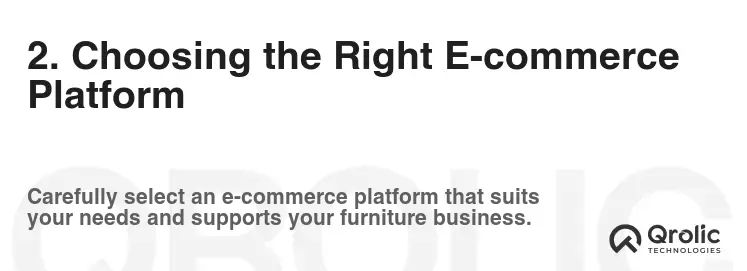
Selecting the right e-commerce platform is a critical decision. It will determine the functionality, scalability, and overall user experience of your website.
2.1 Popular E-commerce Platforms for Furniture Stores
- Shopify: User-friendly, scalable, and offers a wide range of apps and integrations. Excellent for beginners and businesses of all sizes.
- Pros: Easy to use, large app store, strong customer support.
- Cons: Transaction fees (unless using Shopify Payments), limited customization on basic plans.
- WooCommerce (wordpress): Highly customizable and integrates seamlessly with WordPress. Requires more technical expertise.
- Pros: Open-source, highly customizable, large community support.
- Cons: Requires WordPress hosting, more technical knowledge, security management is your responsibility.
- BigCommerce: Designed for large businesses with complex needs. Offers advanced features and scalability.
- Pros: Feature-rich, scalable, strong SEO capabilities.
- Cons: More expensive than Shopify or WooCommerce, steeper learning curve.
- Magento (Adobe Commerce): Powerful and flexible, but requires significant technical expertise and resources. Ideal for enterprise-level businesses.
- Pros: Highly scalable, feature-rich, designed for large businesses.
- Cons: Complex to use, expensive, requires significant technical expertise.
2.2 Key Features to Consider
When choosing an e-commerce platform, consider these essential features:
- Product Management: Easy to add, edit, and organize products.
- Inventory Management: Track stock levels and prevent overselling.
- Shopping Cart and Checkout: Secure and user-friendly checkout process.
- Payment Gateway Integration: Accept various payment methods (credit cards, PayPal, etc.).
- Shipping Options: Offer multiple shipping options and calculate shipping costs accurately.
- Customer Accounts: Allow customers to create accounts, track orders, and save addresses.
- Marketing Tools: Email marketing integration, promotions, and discounts.
- SEO Optimization: Optimize your website for search engines.
- Mobile Responsiveness: Ensure your website looks and functions well on all devices.
- Analytics and Reporting: Track key metrics and gain insights into your business performance.
2.3 Scalability and Future Growth
Choose a platform that can scale with your business as it grows. Consider the platform’s ability to handle increased traffic, product volume, and transaction volume.
Example: If you’re starting small but plan to expand your product line and reach a wider audience, choose a platform like Shopify or BigCommerce that offers scalable plans.
3. Designing Your Furniture Store Website
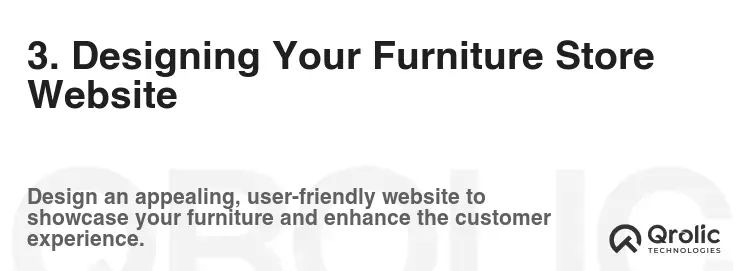
Your website’s design is crucial for attracting and retaining customers. It should be visually appealing, easy to navigate, and optimized for conversions.
3.1 Choosing a Theme or Template
Most e-commerce platforms offer a variety of themes and templates specifically designed for furniture stores. Choose one that aligns with your brand identity and showcases your products effectively.
- Consider these factors:
- Visual Appeal: Does the theme look modern and professional?
- Responsiveness: Is it mobile-friendly?
- Customization Options: Can you easily customize the theme to match your brand?
- Features: Does it include features like product zoom, quick view, and customer reviews?
- Page Load Speed: Is the theme optimized for fast loading times?
- Popular Theme Providers:
- ThemeForest: Offers a wide variety of premium themes.
- TemplateMonster: Another popular source for premium themes.
- Shopify Theme Store: Offers themes specifically designed for Shopify.
3.2 Structuring Your Website Navigation
A clear and intuitive navigation structure is essential for a good user experience.
- Essential Pages:
- Homepage: Showcase your best-selling products, promotions, and brand story.
- Shop Page: Display all your products in an organized manner.
- Product Pages: Provide detailed product information, high-quality images, and customer reviews.
- About Us Page: Tell your brand story and build trust with customers.
- Contact Us Page: Provide contact information and a contact form.
- Blog: Share informative and engaging content related to furniture and design.
- Navigation Menu:
- Keep it simple and clear.
- Use descriptive labels.
- Categorize your products logically.
- Include a search bar.
- Consider using a mega menu for large product catalogs.
3.3 High-Quality Product Photography
Product photography is critical for selling furniture online. Invest in high-quality images that showcase your products in detail.
- Types of Product Photos:
- Hero Shots: Show the entire product in a well-lit setting.
- Lifestyle Shots: Show the product in a real-life setting.
- Detail Shots: Highlight specific features and textures.
- 360° Views: Allow customers to rotate the product and view it from all angles.
- Tips for Product Photography:
- Use a professional photographer or invest in good equipment.
- Use natural lighting whenever possible.
- Shoot from multiple angles.
- Edit your photos to ensure they are consistent and visually appealing.
- Optimize your images for web use (reduce file size without sacrificing quality).
3.4 Incorporating 3D Models and Augmented Reality (AR)
Consider using 3D models and AR to allow customers to visualize furniture in their own homes.
- Benefits of 3D Models and AR:
- Improved Customer Experience: Allows customers to see how the furniture will look in their space.
- Increased Sales: Helps customers make informed decisions and reduces the risk of returns.
- Competitive Advantage: Differentiates your website from competitors.
- Tools for Creating 3D Models and AR Experiences:
- SketchUp: A popular 3D modeling software.
- Blender: A free and open-source 3D creation suite.
- ARKit (iOS) and ARCore (Android): Platforms for developing AR apps.
3.5 Website Speed and Performance
A fast-loading website is essential for a good user experience and SEO.
- Tips for Improving Website Speed:
- Optimize your images.
- Use a content delivery network (CDN).
- Minimize HTTP requests.
- Enable browser caching.
- Choose a fast hosting provider.
- Use a lightweight theme.
- Minify CSS and JavaScript files.
4. Optimizing Your Website for Search Engines (SEO)

SEO is crucial for driving organic traffic to your furniture store website.
4.1 Keyword Research
Identify the keywords that your target audience is using to search for furniture online.
- Tools for Keyword Research:
- Google Keyword Planner: A free tool from Google that provides keyword suggestions and search volume data.
- SEMrush: A comprehensive SEO tool that offers keyword research, competitor analysis, and site auditing.
- Ahrefs: Another popular SEO tool with similar features to SEMrush.
- Moz Keyword Explorer: A tool from Moz that helps you find and analyze keywords.
- Types of Keywords:
- Head Keywords: Broad keywords with high search volume (e.g., “furniture”).
- Long-Tail Keywords: More specific keywords with lower search volume but higher conversion rates (e.g., “modern sofa with wooden legs”).
- Focus on a mix of head keywords and long-tail keywords to attract a wider audience.
4.2 On-Page Optimization
Optimize your website’s content and structure for search engines.
- Title Tags: Use relevant keywords in your title tags to tell search engines what your pages are about.
- Meta Descriptions: Write compelling meta descriptions that encourage users to click on your search results.
- Header Tags (H1-H6): Use header tags to structure your content and highlight important keywords.
- URL Structure: Create clear and descriptive URLs that include relevant keywords.
- Image Alt Text: Add alt text to your images to describe them to search engines.
- Internal Linking: Link to other relevant pages on your website to improve navigation and SEO.
- Content Quality: Create high-quality, informative, and engaging content that provides value to your audience.
4.3 Off-Page Optimization
Build backlinks from other reputable websites to increase your website’s authority.
- Strategies for Building Backlinks:
- Guest Blogging: Write guest posts for other websites in your industry and include a link back to your website.
- Linkable Assets: Create valuable content (e.g., infographics, guides, tools) that other websites will want to link to.
- Broken Link Building: Find broken links on other websites and offer to replace them with links to your content.
- Directory Submissions: Submit your website to relevant online directories.
- Social Media Promotion: Promote your content on social media to increase its visibility and attract backlinks.
4.4 Mobile Optimization
Ensure your website is fully optimized for mobile devices.
- Mobile-Friendly Design: Use a responsive design that adapts to different screen sizes.
- Fast Loading Times: Optimize your website for fast loading times on mobile devices.
- Touch-Friendly Navigation: Make sure your navigation is easy to use on touchscreens.
- Mobile-Specific Content: Consider creating mobile-specific content that is tailored to the needs of mobile users.
4.5 Local SEO
If you have a physical store, optimize your website for local search.
- Google My Business: Create and optimize your Google My Business listing.
- Local Citations: List your business in relevant online directories and citation sites.
- Local Keywords: Use local keywords in your website content and meta tags.
- Customer Reviews: Encourage customers to leave reviews on Google and other review sites.
5. Setting Up Payment and Shipping Options
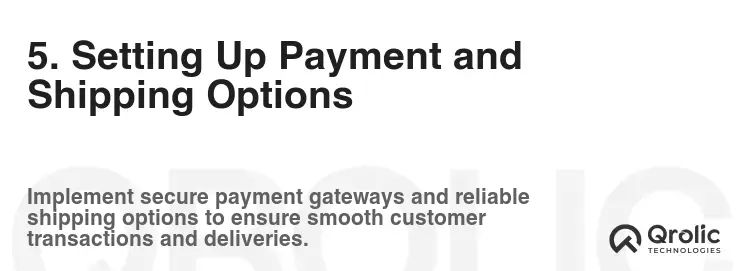
Providing seamless and secure payment and shipping options is essential for a positive customer experience.
5.1 Payment Gateway Integration
Choose a payment gateway that supports various payment methods and offers secure transactions.
- Popular Payment Gateways:
- PayPal: A widely used payment gateway that offers secure online payments.
- Stripe: A developer-friendly payment gateway that offers a wide range of features.
- Authorize.net: A popular payment gateway that integrates with many e-commerce platforms.
- Square: A payment gateway that offers both online and offline payment processing.
- Factors to Consider:
- Transaction Fees: Compare the transaction fees of different payment gateways.
- Security: Choose a payment gateway that offers robust security features.
- Integration: Ensure the payment gateway integrates seamlessly with your e-commerce platform.
- Customer Support: Choose a payment gateway with reliable customer support.
5.2 Shipping Options and Rates
Offer multiple shipping options and calculate shipping costs accurately.
- Shipping Methods:
- Flat Rate Shipping: Charge a flat rate for all orders.
- Weight-Based Shipping: Calculate shipping costs based on the weight of the order.
- Real-Time Shipping Rates: Integrate with shipping carriers like UPS, FedEx, and USPS to get real-time shipping rates.
- Free Shipping: Offer free shipping on orders over a certain amount.
- Shipping Carriers:
- UPS: A popular shipping carrier that offers a wide range of services.
- FedEx: Another popular shipping carrier with similar services to UPS.
- USPS: The United States Postal Service, a reliable and affordable shipping option.
- Shipping Policies:
- Clearly outline your shipping policies on your website.
- Include information about shipping times, costs, and restrictions.
- Provide tracking information to customers so they can track their orders.
5.3 Order Fulfillment
Choose a fulfillment method that meets your business needs.
- Self-Fulfillment: Fulfill orders yourself from your own warehouse or storage space.
- Dropshipping: Partner with a supplier who fulfills orders directly to your customers.
- Third-Party Logistics (3PL): Outsource your order fulfillment to a 3PL provider.
6. Marketing and Promotion
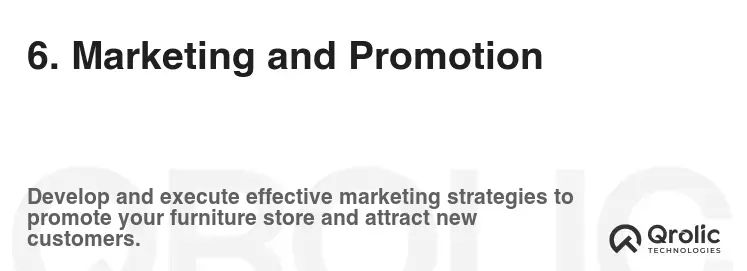
Once your website is live, you need to market and promote it to attract customers.
6.1 Email Marketing
Build an email list and send regular newsletters to promote your products and offers.
- Email Marketing Platforms:
- Mailchimp: A popular email marketing platform with a free plan for small businesses.
- Klaviyo: An email marketing platform specifically designed for e-commerce businesses.
- Constant Contact: A user-friendly email marketing platform for small businesses.
- Email Marketing Strategies:
- Build an email list by offering a discount or free gift for signing up.
- Send welcome emails to new subscribers.
- Send regular newsletters with product updates, promotions, and design tips.
- Segment your email list to send targeted emails to specific groups of customers.
- Automate your email marketing to send emails based on specific triggers (e.g., abandoned cart emails).
6.2 Social Media Marketing
Use social media to connect with your target audience and promote your products.
- Social Media Platforms:
- Facebook: A popular social media platform with a large user base.
- Instagram: A visual platform that is ideal for showcasing your furniture.
- Pinterest: A platform for sharing and discovering ideas, perfect for furniture and design inspiration.
- Twitter: A platform for sharing news, updates, and engaging with your audience.
- Social Media Strategies:
- Create engaging content that showcases your furniture and design expertise.
- Run contests and giveaways to attract new followers.
- Use relevant hashtags to reach a wider audience.
- Engage with your followers and respond to their comments and questions.
- Use social media advertising to target specific demographics and interests.
6.3 Paid Advertising
Use paid advertising to drive traffic to your website and generate sales.
- Google Ads: A platform for running search and display ads on Google.
- Social Media Ads: Platforms for running ads on social media platforms like Facebook, Instagram, and Pinterest.
- Types of Ads:
- Search Ads: Ads that appear in search results when users search for specific keywords.
- Display Ads: Ads that appear on websites and apps across the Google Display Network.
- Social Media Ads: Ads that appear on social media platforms.
- Advertising Strategies:
- Target your ads to specific demographics, interests, and locations.
- Use relevant keywords in your ad copy.
- Create compelling ad creatives that showcase your furniture.
- Track your ad performance and make adjustments as needed.
6.4 Content Marketing
Create valuable content that attracts and engages your target audience.
- Types of Content:
- Blog Posts: Share informative and engaging content related to furniture and design.
- Guides: Create comprehensive guides on topics like choosing the right furniture for your home or decorating your space.
- Infographics: Create visually appealing infographics that present data and information in an easy-to-understand format.
- Videos: Create videos that showcase your furniture, provide design tips, or tell your brand story.
- Content Marketing Strategies:
- Identify your target audience’s needs and interests.
- Create content that addresses those needs and interests.
- Promote your content on social media and other channels.
- Track your content performance and make adjustments as needed.
6.5 Influencer Marketing
Partner with influencers in the furniture and design industry to promote your products.
- Find influencers who align with your brand and target audience.
- Offer influencers free products or compensation in exchange for promoting your products.
- Ensure that influencers disclose their relationship with your brand.
7. Customer Service and Support
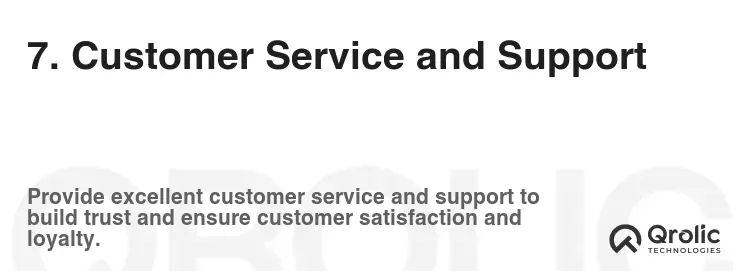
Providing excellent customer service and support is crucial for building customer loyalty and generating repeat business.
7.1 Live Chat
Implement live chat on your website to provide instant support to customers.
- Live Chat Platforms:
- LiveChat: A popular live chat platform with a wide range of features.
- Intercom: A customer messaging platform that offers live chat, email marketing, and other features.
- Zendesk Chat: A live chat platform from Zendesk that integrates with their customer service software.
7.2 Email Support
Provide prompt and helpful email support to customers who have questions or issues.
- Respond to emails within 24 hours.
- Provide clear and concise answers to customer questions.
- Be polite and professional in your communication.
7.3 Phone Support
Offer phone support to customers who prefer to speak to a representative directly.
- Provide a dedicated phone number for customer support.
- Train your customer service representatives to handle customer inquiries effectively.
- Offer extended support hours to accommodate customers in different time zones.
7.4 Returns and Exchanges
Have a clear and easy-to-understand returns and exchanges policy.
- Make it easy for customers to return or exchange products.
- Offer free returns or exchanges whenever possible.
- Process returns and exchanges promptly.
7.5 Customer Reviews
Encourage customers to leave reviews on your website and other review sites.
- Customer reviews can build trust and credibility.
- Respond to customer reviews promptly and professionally.
- Use customer feedback to improve your products and services.
8. Website Maintenance and Updates
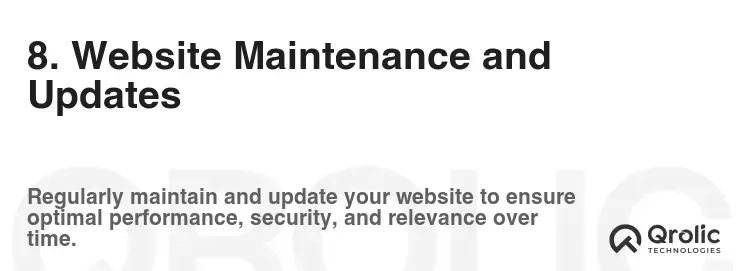
Regular website maintenance and updates are essential for ensuring your website remains secure, functional, and up-to-date.
8.1 Security Updates
Install security updates regularly to protect your website from hackers and malware.
- Keep your e-commerce platform and plugins up-to-date.
- Use strong passwords and change them regularly.
- Install a security plugin or firewall.
- Back up your website regularly.
8.2 Content Updates
Keep your website content fresh and up-to-date.
- Add new products regularly.
- Update your product descriptions and images.
- Publish new blog posts and articles.
- Remove outdated content.
8.3 Performance Monitoring
Monitor your website’s performance regularly to identify and fix any issues.
- Use website analytics tools to track key metrics like traffic, bounce rate, and conversion rate.
- Monitor your website’s loading speed.
- Check for broken links and fix them promptly.
9. Qrolic Technologies: Your Partner in Building a Successful Furniture Store Website
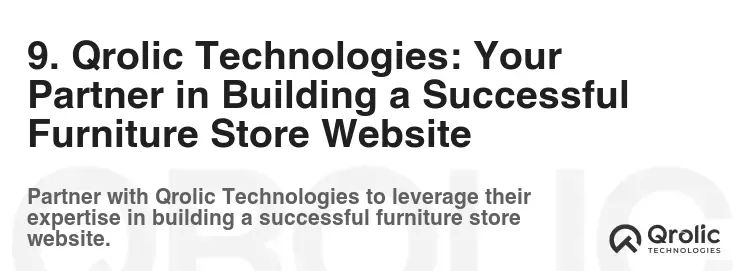
Creating a successful furniture store website requires expertise in various areas, from website design and development to SEO and marketing. Qrolic Technologies (https://qrolic.com/) offers comprehensive solutions to help you build and grow your online furniture business.
9.1 Services Offered
- E-commerce Website Development: Qrolic Technologies can develop a custom e-commerce website tailored to your specific needs and requirements. They have expertise in various e-commerce platforms like Shopify, WooCommerce, and Magento.
- Website Design: Qrolic Technologies can design a visually appealing and user-friendly website that reflects your brand identity and showcases your furniture effectively.
- SEO Optimization: Qrolic Technologies can optimize your website for search engines to improve your organic rankings and drive more traffic to your website.
- Digital Marketing: Qrolic Technologies can develop and execute a comprehensive digital marketing strategy to promote your furniture store website and generate sales.
- Website Maintenance and Support: Qrolic Technologies offers ongoing website maintenance and support to ensure your website remains secure, functional, and up-to-date.
- Retail Design: Qrolic Technologies offers retail design solutions for furniture stores.
9.2 Benefits of Choosing Qrolic Technologies
- Experienced Team: Qrolic Technologies has a team of experienced professionals with expertise in e-commerce, website design, SEO, and digital marketing.
- Custom Solutions: Qrolic Technologies provides custom solutions tailored to your specific business needs.
- Results-Driven Approach: Qrolic Technologies is committed to delivering results and helping you achieve your business goals.
- Affordable Pricing: Qrolic Technologies offers competitive pricing without compromising on quality.
- Excellent Customer Support: Qrolic Technologies provides excellent customer support to ensure you are satisfied with their services.
10. Measuring Your Success
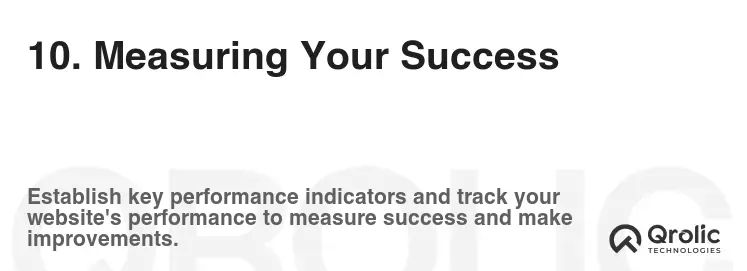
It’s crucial to track your website’s performance to see what’s working and what’s not. Use these key metrics:
- Website Traffic: How many visitors are coming to your site? Use Google Analytics to track this.
- Bounce Rate: What percentage of visitors leave after viewing only one page? A high bounce rate indicates a problem with your site’s content or usability.
- Conversion Rate: What percentage of visitors make a purchase? This is a key indicator of your website’s effectiveness.
- Average Order Value: How much does the average customer spend?
- Customer Acquisition Cost (CAC): How much does it cost to acquire a new customer?
- Customer Lifetime Value (CLTV): How much revenue does a customer generate over their relationship with your business?
Regularly analyze these metrics and adjust your strategy as needed to improve your website’s performance and achieve your business goals.
By following these essential steps, you can create a furniture store website that attracts customers, showcases your products effectively, and drives sales. Remember to focus on user experience, SEO, and customer service to build a successful online furniture business.









